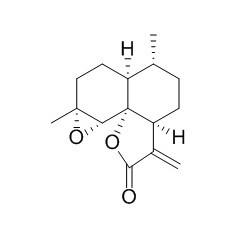Arteannuin B
Arteannuin B and artemisinic acid are biogenetic precursors of artemisinin, an important antimalarial produced by the herb Artemisia annua, they are active against different bacteria and certain fungal species. Arteannuin B has potential antimalarialand antitumor activity.
Inquire / Order:
manager@chemfaces.com
Technical Inquiries:
service@chemfaces.com
Tel:
+86-27-84237783
Fax:
+86-27-84254680
Address:
1 Building, No. 83, CheCheng Rd., Wuhan Economic and Technological Development Zone, Wuhan, Hubei 430056, PRC
Providing storage is as stated on the product vial and the vial is kept tightly sealed, the product can be stored for up to
24 months(2-8C).
Wherever possible, you should prepare and use solutions on the same day. However, if you need to make up stock solutions in advance, we recommend that you store the solution as aliquots in tightly sealed vials at -20C. Generally, these will be useable for up to two weeks. Before use, and prior to opening the vial we recommend that you allow your product to equilibrate to room temperature for at least 1 hour.
Need more advice on solubility, usage and handling? Please email to: service@chemfaces.com
The packaging of the product may have turned upside down during transportation, resulting in the natural compounds adhering to the neck or cap of the vial. take the vial out of its packaging and gently shake to let the compounds fall to the bottom of the vial. for liquid products, centrifuge at 200-500 RPM to gather the liquid at the bottom of the vial. try to avoid loss or contamination during handling.
Chem Res Toxicol.2023, 36(2):213-229.
In Vivo.2022, 36(3):1136-1143.
J Chromatogr B Analyt Technol Biomed Life Sci.2020, 1149:122123.
Cancers (Basel).2021, 13(17):4327.
Evid Based Complement Alternat Med.2021, 2021:5023536.
Nutrients.2024, 16(7):985.
J Ethnopharmacol.2024, 320:117426.
Food Chem.2020, 332:127412
J Med Food.2024, 27(8):728-739.
Biomedicines.2024, 12(12):2928.
Related and Featured Products
Yao Xue Xue Bao. 1992;27(4):317-20.
Derivatives of arteannuin B with antileukemia activity[Pubmed:
1442049]
METHODS AND RESULTS:
Arteannuin B (I) was converted to hydroxy lactones (VII, VIII) by a mixture of formic acid and sulfuric acid. Compound VI and Compound VII both showed activity against leukemia P 388 cell in vitro. The rate of growth inhibition were 97.5% and 11.8% for (VI) and 80% and 52.6% for (VII) at the concentration of 10 and 1 micrograms/ml respectively.
CONCLUSIONS:
It seems that the antileukemia activity of 6-membered lactone is higher than that of 5-membered and the methylene group is necessary for the antileukemia activity.
Current Science, 2000 , 78 (6) :709-713.
Antimicrobial activity of artemisinin and its precursors.[Reference:
WebLink]
Artemisinic acid and Arteannuin B are biogenetic precursors of artemisinin, an important antimalarial produced by the herb Artemisia annua. These compounds have been screened for antimicrobial activity against a range of organisms.
CONCLUSIONS:
All the three compounds are active against different bacteria and certain fungal species.
J Sep Sci. 2005 Nov;28(17):2288-92.
Simultaneous densitometric determination of artemisinin, artemisinic acid and arteannuin-B in Artemisia annua using reversed-phase thin layer chromatography.[Pubmed:
16342793]
METHODS AND RESULTS:
A rapid and simple RP-TLC method for simultaneous quantification of pharmacologically important sesquiterpene artemisinin (AM) together with its precursors Arteannuin B (AB) and artemisinic acid (AA) in the inflorescence part of Artemisia annua plant has been developed. The RP-TLC of sesquiterpenes was performed on RP-18 F254 S thin-layer chromatographic plates by developing in mobile phase, containing 0.2% TFA in water/ACN (35:65, v/v). The densitometric determination of AM, AB and AA was carried out after derivatization with anisaldehyde reagent at 426 nm in absorption-reflectance mode.
J Nat Prod. 1993 Sep;56(9):1559-66.
Bioconversion of arteannuin B to artemisinin.[Pubmed:
8254350]
Arteannuin B, which co-occurs with artemisinin, the potent antimalarial principle of the Chinese medicinal herb Artemisia annua (Asteraceae), has been converted to the latter using crude and semi-purified cell-free extracts of the leaf homogenates of the plant. Detection procedures to quantitate this bioconversion, including one that is novel which uses gcms, are detailed.
8. IUPAC symposium on organometallic chemistry directed towards organic synthesis, Santa Barbara, CA (United States), 6-10 Aug 1995.
Samarium(II) induced asymmetric reductive cyclizations: The total synthesis of (-)-C{sub 10} desmethyl arteannuin B[Reference:
WebLink]
Arteannuin B is a member of the qinghaosu family, a novel class of sesquiterpenes that exhibit powerful antimalarial activity even against chloroquinine resistant strains. It is readily convertible to qinghaosu in several high yielding steps and has potential antitumor activity. Several approaches to the construction of the cis-decalin backbone have involved the use of electrochemical and metal promoted reductions as well as alkylations.
METHODS AND RESULTS:
We report a short convenient total synthesis of (-)-C{sub 10} desmethyl Arteannuin B utilizing an asymmetric reductive cyclization with samarium (II) iodide which selectively forms the cis-decalin ring structure while setting the trans relationship between the subunits of the {gamma}-hydroxy ester.



